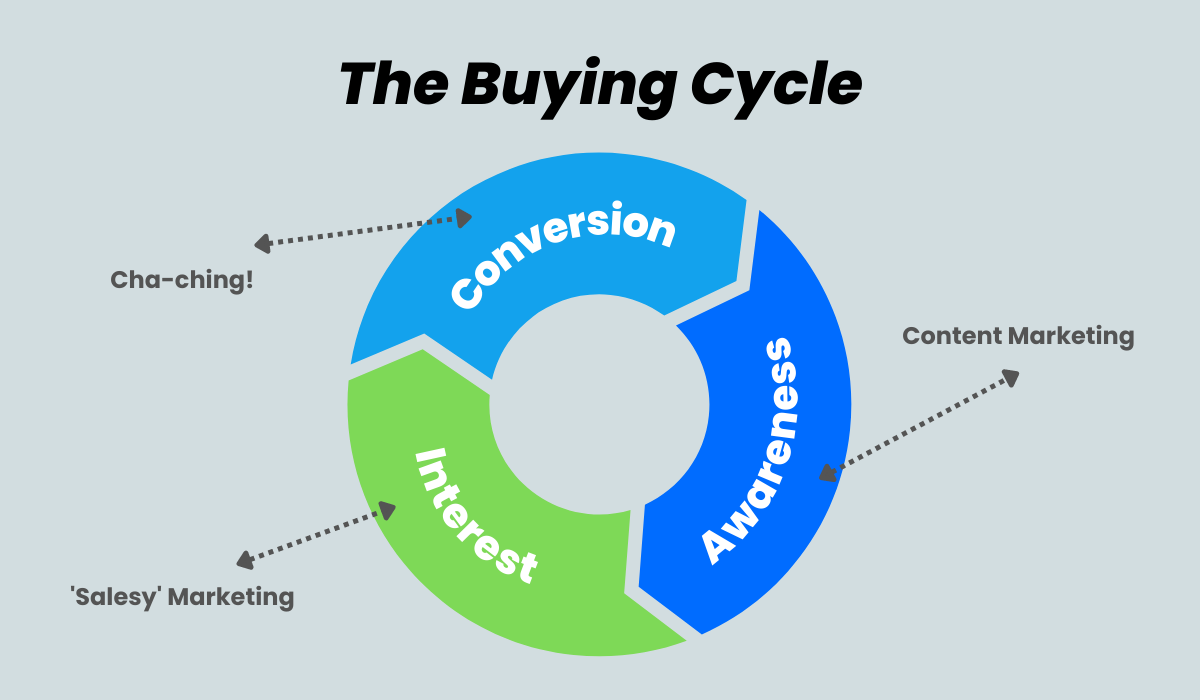If you own a business, you’ve probably come across the term ‘content marketing’. But do you know what content marketing really is? And more importantly, are you using it correctly? If you’re anything like most people, chances are you’re probably not. So, here are the ins and outs of content marketing, and how to utilise it for your business.
What is Content Marketing?
If you give ‘content marketing’ a quick search, you’ll come across something convoluted like this:
‘Content marketing is a type of marketing that involves the creation and sharing of online material that does not promote a business but instead stimulates interest in its services or products.’
… sorry, what?
Let’s break that down. Basically, content marketing is one of many strategies used in digital marketing to promote a brand or business. As the name suggests, content marketing relies on digital content (think blogs, social media posts, infographics, podcasts) to drive leads, without being overtly ‘salesy’. Instead, content marketing is used to inform, inspire, and entertain.
Still confused? Imagine you’ve landed on the Facebook page of a local café. You scroll down, and find two recent posts…
Post one: a picture of a smashed avo dish on a fancy black plate, with the caption ‘Head down to Café Coffee Melbourne and try our new smashed avo today! (This is an example of traditional, ‘salesy’ digital marketing).
Post two: a picture of half an avocado sitting on a wooden chopping board, with the caption ‘Hot tip! Did you know that half an avocado a day can provide a good serving of healthy fats?’ (This is an example of content marketing.)
See the difference? Both posts are a form of digital marketing, but one post is intended to sell you something, and the other is intended to inform, and inspire.
Why is Content Marketing Important?
Content marketing is an important tool in the marketer’s toolbox for a couple of reasons. Firstly, most of the people in your target audience are very used to seeing ads, and overt ‘salesy’ content. In fact, they can smell it from a mile away, and will quickly switch off if they’re not interested. But with content marketing, you’re engaging your audience first, while subtly building brand awareness. Think about it—as a consumer, are you more likely to direct your interest to a piece of content clearly designed to sell you a plate of smashed avo, at a café you’ve never been to? Or are you more likely to read a tip about why half an avo a day keeps the doctor away? … That’s what I thought.
Secondly, we live in a digital age, and your business needs to compete with flashy videos, bright colours, and appeal to extremely short attention spans. Do you think your perfectly laid-out sales graphics are going to win the bid for attention, over a cat wearing a sombrero? Probably not. But an on-brand piece of content that’s interesting, inspiring, and attention-grabbing just might.

How Does Content Marketing Work?
Okay, so content marketing is more subtle and grabs attention… but how does it actually sell? And why am I paying for ‘more overt’ marketing, like ads? Great question! Let me introduce you to the buying cycle.
Stage One: Awareness
This is the first stage of the cycle. At this point, your customer has a ‘problem’ they need to solve, but they don’t know it yet. Or maybe they’re aware of their problem, but they don’t realise there’s a solution. For example’s sake, let’s say your business manufactures and sells plastic tongs to retrieve toast easily and safely from the toaster. Your prospective customer burns their fingers on their toaster every morning, and doesn’t know there’s a better way. Suddenly, your customer comes across your content online, and now they need toast tongs. In other words, your customer has just become aware of your brand and products.
Stage Two: Interest
Now comes stage two. In the interest stage, the customer will research toast tongs on social media, on Google, and wherever else they can find information. They want to find the best deal, and the most suitable product for them and their toaster.
Stage Three: Conversion
At stage three, the customer has completed their research, and has decided your product is the best value. They place an order, and you get paid. Cha-ching! There you have it—the buying cycle.
Where does content marketing fit in; you might ask? Well, content marketing usually acts as the entry point to the buying cycle. Ideally, your customer will stumble upon a piece of casual, informative content that brings their attention to your brand and products, without being too blatantly ‘salesy’. They’ll notice your content, might even leave a comment on social media, or share your blog post with their friends. Suddenly, they’re aware of your brand, and what your brand does. Queue stage two!
Here’s where traditional digital marketing comes in. Now that your customer has been softly and informally introduced to your brand, they’re more receptive to ads and ‘salesy’ content. Say you’ve recently launched a Google Ad campaign for your ‘B1G1 50% all toast tongs’ sale. Your customer knows about your brand and what you do, thanks to content marketing. So, they’re less likely to ignore your Google Ad, and more likely to make a purchase.
All in all, both approaches are important for most brands, and both approaches tend to work in unison. If you stick to only content marketing, you might not drive people to purchase your products and services. But, if you hammer out a bunch of ads without first building brand awareness, your content might get lost among the sea of gifs and sombrero-wearing cats.
How to Use Content Marketing for Your Business
Congrats—you now know the basics of content marketing! So… how do you utilise content marketing for your business? Well, that’s the million-dollar question.
Really, your approach will vary significantly depending on the type of business you own. Start by identifying your target audience—you’ll never be able to produce eye-catching content that appeals to just everyone. So, really narrow down your customer base, and work out who you’re producing this content for. Once you’ve done that, choose an appropriate format. Are blogs best for your business? Should you have a strong social media presence? What about podcasts? Your chosen audience may give insight into this step, but it also might not.
Now, you’ll need to produce content that is interesting, captivating, and above all else, appropriate for your brand. Would you expect a beauty salon to utilise content in a similar way as a mechanics workshop? Surely not! In other words, take some time to consider your brand’s voice, and create effective content that aligns with it.
But this will take ages! I hear you say. Yep, probably. Effective digital content marketing is no walk in the park. If results came easy, everyone would do it and do it well. If you’re not ready to commit time, effort, and research into your content marketing, give it a miss—because poorly executed content could actually damage your brand. But… there is another way.
Here at Clixium Digital Marketing, we create effective, eye-catching, and on-brand content, so you can spend less time worrying about marketing, and spend more time growing your business. Need help with SEO, social media, Google Ads, and websites? We can help there too! Clixium is a one-stop shop for all your digital marketing needs, creating content that captures attention, and taking the fuss out of online marketing. So, click here to learn more about Clixium Digital Marketing, or click here to contact us today!
Related Posts
September 29, 2022
How Website Content Can Help You Win More Leads
Is your website generating loads of…



